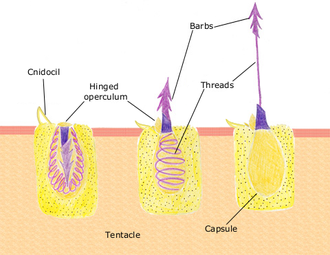Cnida
The cnida is the basic term for the stinging apparatus of the phylum Cnidaria. The whole life-style of the phylum is based on this device, which enables the animals to catch their prey. The cnida appears in several forms: the most usual is the nematocyst.[1]
Cnidae are organelle-like capsules with eversible tubules (they shoot the tubule outwards).[2] They are the diagnostic feature of the phylum. All cnidarians possess cnidae; no loss of the feature is known.
There are three main types of cnidae: nematocysts, ptychocysts, and spirocysts, with many variations. Depending on the species, one or more types may be on the organism.
- Nematocyst. This is the main type, present in all Anthozoa. It is a harpoon-like structure which holds and paralyses small prey.
- Ptychocyst. This puts out a sticky substance. This is used to hold on to prey, and to help make tubes for burrowing tube anemones.
- Spirocyst. This is a lasso-like string that is fired at prey. It wraps around the prey.
The cell which produces the cnida is variously called a cnidocyte, cnidoblast, or nematocyte. It is highly specialised for just one function. Each nematocyte cell contains an organelle with a hollow, coiled, thread-like structure. The outside of the cell has a hair-like trigger. When the trigger is touched, the shaft of the cnidocyst fires like a harpoon. It penetrates the prey, and the hollow thread comes with it. This takes no more than a few microseconds. After penetration, the toxic content of the nematocyst is injected into the target. The rapid activity of the injected neurotoxins paralyzes the mobile prey, thus allowing the sessile cnidarian to devour it.
Kleptocnidy
Certain types of sea slugs, such as the nudibranch aeolids, store nematocysts from digested jellyfish at the tips of their cerata (body projections), a process called kleptocnidy.[3] It is quite common for these predators to store useful components from their prey; another sea slug stores photosynthetic plastids from algae it feeds on to help it blend in with the bed of algae it grazes on.[4]
Cnida Media
Nomarski micrograph of a ruthenium red-stained nematocyst from Aiptasia pallida, the pale anemone. The red dye stains the polyanionic venom proteins found inside the capsule of this partially-discharged nematocyst.
Nematocysts from Chironex fleckeri (400x magnification)
References
- ↑ Daly, Marymegan et al 2007. The phylum Cnidaria: A review of phylogenetic patterns and diversity 300 years after Linnaeus. Zootaxa. 1668, 127–182. [1]
- ↑ Hessinger D.A. & Lenhoff H.M. (eds) 1988. The biology of nematocysts. San Diego: Academic Press.
- ↑ Rudman, W.B., 1999 (July 1) Cerata (ceras) in aeolids. [In] Sea Slug Forum. Australian Museum, Sydney. Available from [2]
- ↑ Rudman, W.B., 1998 (October 14) Stiliger smaragdinus Baba, 1949. [In] Sea Slug Forum. Australian Museum, Sydney. Available from [3]






